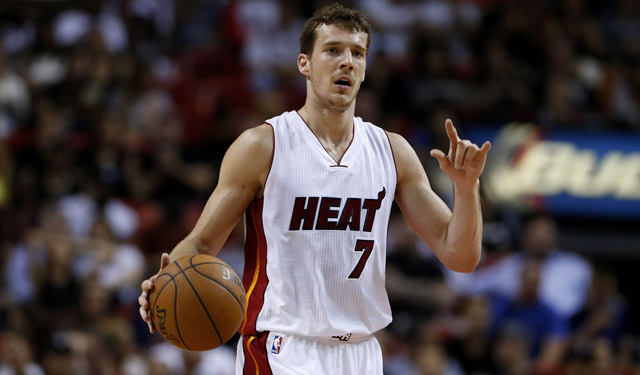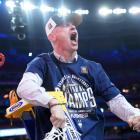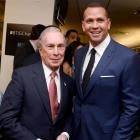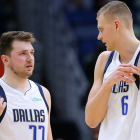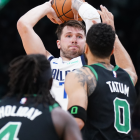MIAMI -- "Which playbook?" Erik Spoelstra answered half-jokingly when asked how much of the Miami Heat's playbook was available in Goran Dragic's first two games with the team.
The excitement of the Dragic acquisition again making the Heat an East contender lasted 20 minutes before news of Chris Bosh's hospitalization hit the team. A day later, Bosh was ruled out the rest of the season because of a blood clot in his lungs and this team was decimated. But Miami had those feelings aside and start getting Dragic acclimated to the team, style and process of what the Heat want to be.
Miami's season has jumped all over the place. A few high (and low) points:
- Lost LeBron James in the summer.
- Re-sign Bosh and Dwyane Wade;; acquire Josh McRoberts and Luol Deng.
- Lose McRoberts to a knee injury.
- Bosh and Wade in and out of the lineup because of various maladies.
- Hassan Whiteside emerges as a legit big man from nowhere.
- Land Dragic on deadline day.
- Learn of Bosh's health concerns.
Consequently, the Heat have been unable to carve any continuity. Only the San Antonio Spurs (23), New York Knicks (29), and Philadelphia 76ers (26) have used more starting lineups than the Heat (22).
"We've had four or five different playbooks this year," Spoelstra said following Dragic's second game with the team. "It's startling how much different our points of emphasis are from training camp and then from December and then January and then February and then now. We scaled it back. We tried to play to our strengths with what we have right now our team is much different than what we had before. That may take some time but we’re not going to try to fast track a new playbook."
Part of that new playbook with Dragic on board is finding a new speed. The Heat often have been selective in pushing the ball. Even with James, the Heat were 23rd and 27th in pace his final two seasons in Miami. This season, they're last. Because of lineup inconsistency, they've chosen to grind out games instead of trying to run against better talent some nights.
With Dragic, the Heat have a player accustomed to a much quicker pace. The Suns are the second-fastest team in the NBA and Dragic is a terror in the open floor. So the Heat are looking to immerse Dragic's tempo into their culture, creating a symbiotic relationship on the fly.
"Obviously, you guys know we're the slowest paced team in the league, so it gives us a different dynamic," Wade said following after Monday's 119-108 win over the 76ers. "Make us get out; make us go. We need some easy ones, easy opportunities."
Part of that different dynamic is finding Dragic off defensive rebounds and letting him tear up the open court to get quick baskets.

Even when surrounded by a pocket of defenders in the open floor, Dragic can deceive those trying to slow him down. His quick, compact dribbling moves help him change direction and momentum of the defender in the blink of an eye, and he capitalizes on those shifts better than most in the open floor. His deception, along with being left-handed, creates chaos in a transition defense.
"I think it is [contagious]," Wade explained about the team running with Dragic. "When a guy has the ball and he's pushing it, if you want it, then you got to get in front of it. You got to get with him. No doubt about it, he's going to make you get out and go. He doesn't even look fast when he's running, but he's quick."
The difference already is noticeable. In their first 53 games, the Heat averaged 92.08 possessions, according to NBA.com/stats. In four games with Dragic, Miami is 26th at 94.8 possessions per game. Nearly three possessions difference, even in such a small sample size, is a significant change.
Miami has seen a jump in fast break points (nearly three points per game) and points in the paint (nearly eight points) with Dragic, although the sample size of four games is a tricky one to dissect. Dragic attacks the basket as well as almost any guard in the NBA and it fits nicely with Spoelstra's system designed to open driving space.
"When we get a rebound, then it's to the races," Dragic said. "We can push the ball, we can make plays, and we score a lot of easy points."
Here are three drives featuring Dragic in attack mode:
It's easy to dismiss these highlights because they're against the Sixers. However, the Sixers are the league's 13th-best defensive team, are 16th in points in the paint allowed (adjusting for pace), and are eighth in opponent's field goal percentage in the restricted area. They may be tanking on offense, but they know how to defend at a pretty solid level, especially around the rim.
Dragic is great at finding driving angles, even against quick, athletic and bigger defenders. He's also physical, using bumps and off-arms to clear the necessary space to get shots off inside. His spacial awareness in relation to the helping big man around the basket is stellar, and his touch around the rim and off the glass make him one of the league's better finishing guards.
Of guards who take at least two shots per game in the restricted area, Dragic's 69.4 percent success rate is the NBA's best. He's the only guard in the top 20 for restricted area field goal percentage -- a special player around the basket.
In Dragic's first game with the Heat, he was thrown into the fire right away. A 45-minute walkthrough was his only real orientation; the perils of being traded in-season when the schedule is unrelenting. Dragic described the experience of meeting his teammates for the first time and struggling through his first game as, "At least I broke the ice." Prior to the game and during stoppages, Wade spent time trying to familarize his new teammate with his new surroundings.
"It looked like we were strangers out there on both ends of the court," Spoelstra said after that first game. "We can fix that, we will continue to try and simplify things and try to make guys feel comfortable but also to a point where they are not thinking out there. I told him we will be able to get him comfortable where he can be aggressive and have more opportunities to make plays for our team.”
A voluntary, impromptu practice between Dragic's second and third games in a four-day stretch helped bring him up to speed a bit more as he practiced with "players who were not playing so much." They showed Dragic some of the beats of the system, and where he needs to be both with and without the ball.
“If we have a little more practice time, then you’re not thinking," Dragic said after his second game with Miami. "You're just relaxed and you just play your game."
That's just what the Heat want, because they believe his game will mesh perfectly with what they want to do but have been limited because of personnel and injury issues. The roster's overhaul the past few months has led to their two starting big men out for the season and now three different in-season free-agent scrap pickups in the rotation. Whiteside turned out to be a gem, but now they're taking a look at Henry Walker and Michael Beasley (for a third stint).
With Dragic on the court in four, the team is a plus-5.2 points per 100 possessions. That's a significant separation in the score for Miami. When you factor in that they're minus-17.1 points per 100 with him on the bench over four games, you see just how vital he is to a thin roster.
The next key for Spoelstra and his team is making to split duties properly between Wade and Dragic in the half court. Dragic's ability to suck the defense into the paint to set up his step-back jumper are as important to his attack as his ability to finish inside.

Over the previous two seasons, Dragic made more than 40 percent of his long two-point jumpers. While that's not an efficient shot to take, if he's hitting better than 40 percent of them, you don't mind them sprinkled in. As long as he's not settling for them, they can go a long way for the Heat. With Wade handling the ball quite a bit, Dragic will need to find ways to move into open spots and be ready for a pass.
It also works the other way around too.
"Both are going to have to be dynamic," Spoelstra said. "There's going to be enough opportunities for both of them to be aggressive. We think they’re a great fit together. That’ll take a little bit of time to build that community. We have two dynamic playmakers."
Now the rest of the team has to adjust to the new backcourt and provide necessary support, spacing, movement and running mates to make everything click. But they trust their new point guard to understand it quickly, which should make the transition pretty seamless.
"He has a high-level IQ, which makes it easier for everybody," said Deng.
What ends happens with Dragic's future -- he'll be an unrestricted free agent this summer -- has to be put aside as they figure out the present. The Heat are expected to throw an enormous contract at him, even though they won't see Dragic on the floor with Wade and Bosh. They'll just have to trust their instinct about how he fits.
When they are able to finally play together on the court, assuming things keep going to plan with re-signing Dragic and the return of a healthy Bosh, Spoelstra should have a pretty special playbook ready for them to execute.
